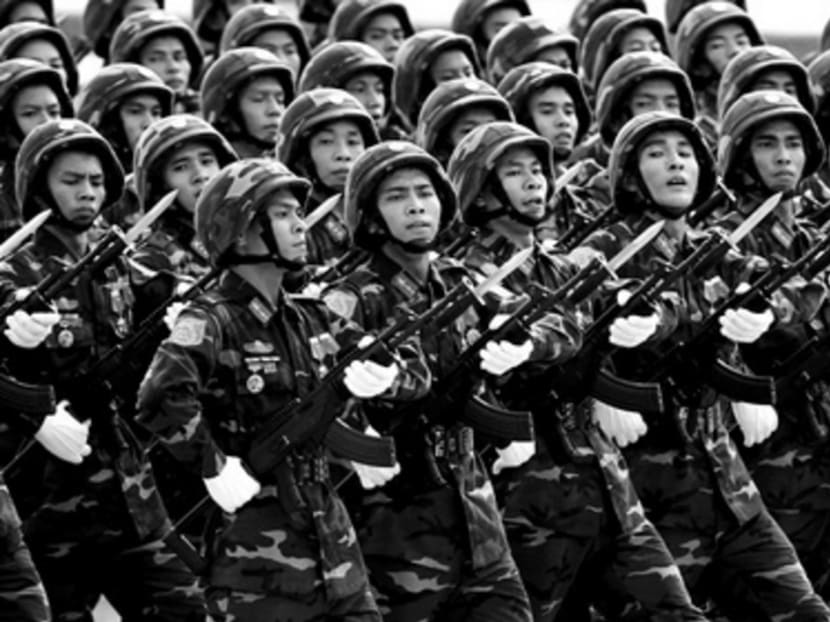Lifting of arms-sale ban largely a symbolic move
Media reports last week suggest that Vietnam was quietly hosting a defence symposium attended by top American arms manufacturers such as Boeing and Lockheed Martin. The symposium took place just days ahead of United States President Barack Obama’s upcoming official visit to Vietnam on Sunday, and seems to confirm the rumour that Mr Obama may fully lift the ban on lethal-weapon sales to Hanoi.

Soldiers during National Day in Hanoi on Sept 2 last year. Facing increasing pressures from Beijing in the South China Sea, Vietnam has been investing considerably in its military capabilities. Photo: Reuters
Media reports last week suggest that Vietnam was quietly hosting a defence symposium attended by top American arms manufacturers such as Boeing and Lockheed Martin. The symposium took place just days ahead of United States President Barack Obama’s upcoming official visit to Vietnam on Sunday, and seems to confirm the rumour that Mr Obama may fully lift the ban on lethal-weapon sales to Hanoi.
The Vietnamese Ministry of Foreign Affairs has welcomed such a prospect, saying that the move will further boost the growing mutual trust between the two former enemies. However, US Assistant Secretary of State for East Asian and Pacific Affairs Daniel Russel said last week that no final decision had been made.
Ban partially lifted
The full lifting of the ban would indicate a stronger rapprochement between the two countries, but has also been a subject of debate. While Hanoi would like the ban to be removed as soon as possible, Washington has been rather reluctant due to domestic pressures.
In October 2014, the White House partially lifted the ban, which has been in place since the end of the Vietnam War, to allow for the future transfer of maritime-security-related defence articles to Vietnam.
The full lifting of the ban, however, has not been announced. This is partly because some US politicians and rights activists insist that such a decision should be conditioned upon Vietnam’s human rights record, which has somewhat improved recently but still causes concerns in Washington.
Nevertheless, given the trend of strengthening defence cooperation between the two countries as well as the healthy development of their overall relations during recent years, the full lifting of the embargo seems to be just a matter of time.
Facing increasing pressures from China in the South China Sea, Vietnam has been investing considerably in its military capabilities. According to recent statistics from the Stockholm International Peace Research Institute (Sipri), Vietnam’s total arms imports from 2011 to 2015 represented a 699 per cent increase from 2006 to 2010, turning Vietnam into the eighth-largest arms importer in the world.
gesture denotes the normalisation of ties
Although the eventual removal of the US ban may strengthen this trend, it should not worry countries in the region.
For starters, it is likely that the lifting of the ban will remain largely a symbolic move for some time. Since the partial lifting in 2014, the two sides have not reached any arms deal. Indeed, Vietnam has expressed interest in acquiring two US naval vessels, but after Washington provided details of a possible deal, Hanoi has since not responded.
A full lifting of the embargo will mainly be seen, especially by the Vietnamese side, as a symbol that bilateral relations have fully normalised. Vietnamese officials have repeatedly stressed this objective, referring to the fact that the embargo is the last remnant of the Cold War hostility between the two countries and goes against the trend of strengthening bilateral relations.
Going forward, will the full lifting of the ban result in substantial US arms transfers to Vietnam? This depends on a number of other factors, which currently obstruct such an outcome.
For example, although Vietnam has stepped up its efforts to diversify its sources of arms imports, Russia has remained its single most important partner, accounting for up to 90 per cent of Vietnam’s arms imports in recent years.
The need to maintain compatibility between existing Russian weapon systems with those Vietnam wants to import from the US will be a major hurdle for any possible substantial arms deal between Hanoi and Washington.
Moreover, Vietnam is currently experiencing a burgeoning budgetary deficit, and its government has been trying to improve its fiscal position by curbing its expenditures, including those for security and defence.
Meanwhile, US weapons systems are known to be relatively more costly. These two factors tend to further dim the prospect of Vietnam entering into any major arms deals with the US in the near future.
Weapons are for defence, not offence
Finally, Vietnam’s arms imports from the US, if any, will probably be of a defensive rather than an offensive nature.
Indeed, for the time being, Vietnam’s interest seems to focus on acquiring patrol boats, coastal radars and maritime surveillance aircraft from the US to enhance its maritime capabilities to handle China’s expansion in the South China Sea. These items are generally less expensive, and should not pose any major compatibility problem for Vietnam.
Although the US may fully lift its ban on lethal-weapon sales to Vietnam in the near future, the move should be seen first and foremost as a symbol of the strengthening ties between Hanoi and Washington.
Even in the longer term, the actual impact on the balance of power in the South China Sea should be limited, at best.
However, we should not underestimate the geo-strategic implications of the comprehensive strengthening of US-Vietnam relations as indicated by the lifting of the ban. A stronger partnership between the two, which may ultimately include US access to Vietnam’s military facilities such as the Cam Ranh Bay, or Vietnam’s engagement in the US-led minilateral defence initiatives in the future, may contribute to meaningful transformations in the regional geopolitical landscape.
ABOUT THE AUTHOR:
Le Hong Hiep is a research fellow at the ISEAS-Yusof Ishak Institute.






